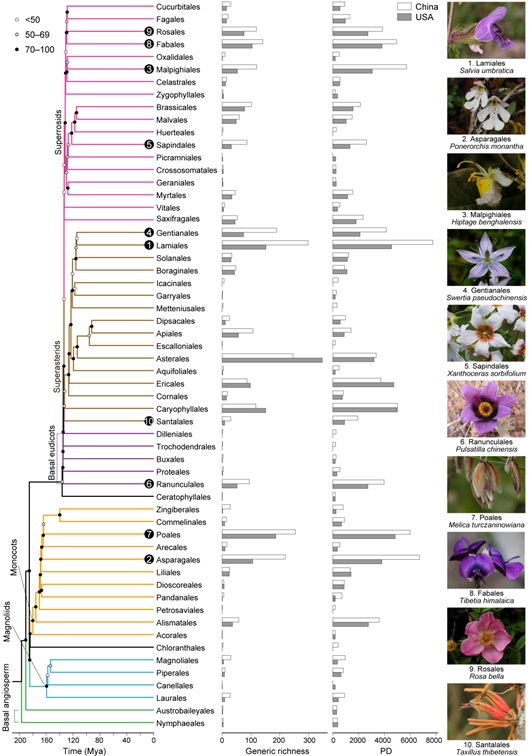Eastern Asia (EA) and North America north of Mexico (NA) share similar geographical environments with comparable latitude, land area and climate. The two regions were once parts of the same ancient landmass (Laurasia), and their extant floras were hypothesized to derive from the once widespread boreotropical flora that spanned the Northern Hemisphere in the Paleocene. However, the number of vascular plant species in EA is 1.5 times larger than in NA. Detailed comparative study of the floras in EA and NA therefore affords an ideal test case for exploring processes that contribute to this highly uneven distribution of plant diversity.
Prof. CHEN Zhiduan's group from the Institute of Botany of the Chinese Academy of Sciences and collaborators from China, the USA and Australia explored the floristic differences between EA and NA and underlying mechanisms using the well-studied floras of China and the 48 contiguous states of the USA as exemplars, by integrating newly generated dated phylogenies of angiosperms from China and the USA and comprehensive spatial distribution data.
Researchers reveals that China possesses both higher richness and phylogenetic diversity (PD) for angiosperms than the USA, and most lineages (46 of 58 orders) in the angiosperm tree of life have contributed to the PD anomaly favoring China. China has preserved a higher proportion of genera that originated before the Miocene than the USA (30% vs 23%), and southern China bears the signature of both old and new diversification.
Both the floras in China and the USA share the signature of an older east and a younger west, and China shows greater east-west deviation in divergence time and diversity than the USA. The patterns within the USA are more complex than those of China, with the east possessing lower genus richness but higher PD and more ancient lineages than the west. Researchers suggest that the diversity anomaly between China and the USA might be largely driven by regional orogenic activities and climatic changes in the west of the two regions by incorporating geological and climatic evidence.
Finally, the study identifies phylogenetic diversity hotspots at both the genus and species levels for angiosperms of China and the USA, and suggests that more conservation areas in southern China and the eastern USA are needed to improve plant conservation efforts in the two countries. In particular, the phylogenetic diversity analyses in this study support the recognition of the 36th global biodiversity hotspot, the North American Coastal Plain. Researchers therefore highlight that phylogenetic diversity is a key metric in biodiversity conservation, which can be used to identify geo-regions with maximum underlying diversity (e.g. the extent of genetic diversity, evolutionary history or functional diversity of a flora).

A summary order-level chronogram of angiosperms and generic richness and phylogenetic diversity (PD) of each order in China (hollow bar) and the USA (gray bar).
Articlelink:https://academic.oup.com/nsr/advance-article/doi/10.1093/nsr/nwab199/6447554?searchresult=1
Contact:
Email:liminlu@ibcas.ac.cn
Institute of Botany of the Chinese Academy of Sciences
Eastern Asia (EA) and North America north of Mexico (NA) share similar geographical environments with comparable latitude, land area and climate. The two regions were once parts of the same ancient landmass (Laurasia), and their extant floras were hypothesized to derive from the once widespread boreotropical flora that spanned the Northern Hemisphere in the Paleocene. However, the number of vascular plant species in EA is 1.5 times larger than in NA. Detailed comparative study of the floras in EA and NA therefore affords an ideal test case for exploring processes that contribute to this highly uneven distribution of plant diversity.
Prof. CHEN Zhiduan's group from the Institute of Botany of the Chinese Academy of Sciences and collaborators from China, the USA and Australia explored the floristic differences between EA and NA and underlying mechanisms using the well-studied floras of China and the 48 contiguous states of the USA as exemplars, by integrating newly generated dated phylogenies of angiosperms from China and the USA and comprehensive spatial distribution data.
Researchers reveals that China possesses both higher richness and phylogenetic diversity (PD) for angiosperms than the USA, and most lineages (46 of 58 orders) in the angiosperm tree of life have contributed to the PD anomaly favoring China. China has preserved a higher proportion of genera that originated before the Miocene than the USA (30% vs 23%), and southern China bears the signature of both old and new diversification.
Both the floras in China and the USA share the signature of an older east and a younger west, and China shows greater east-west deviation in divergence time and diversity than the USA. The patterns within the USA are more complex than those of China, with the east possessing lower genus richness but higher PD and more ancient lineages than the west. Researchers suggest that the diversity anomaly between China and the USA might be largely driven by regional orogenic activities and climatic changes in the west of the two regions by incorporating geological and climatic evidence.
Finally, the study identifies phylogenetic diversity hotspots at both the genus and species levels for angiosperms of China and the USA, and suggests that more conservation areas in southern China and the eastern USA are needed to improve plant conservation efforts in the two countries. In particular, the phylogenetic diversity analyses in this study support the recognition of the 36th global biodiversity hotspot, the North American Coastal Plain. Researchers therefore highlight that phylogenetic diversity is a key metric in biodiversity conservation, which can be used to identify geo-regions with maximum underlying diversity (e.g. the extent of genetic diversity, evolutionary history or functional diversity of a flora).

A summary order-level chronogram of angiosperms and generic richness and phylogenetic diversity (PD) of each order in China (hollow bar) and the USA (gray bar).
Articlelink:https://academic.oup.com/nsr/advance-article/doi/10.1093/nsr/nwab199/6447554?searchresult=1
Contact:
Email:liminlu@ibcas.ac.cn
Institute of Botany of the Chinese Academy of Sciences
